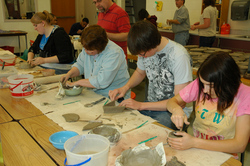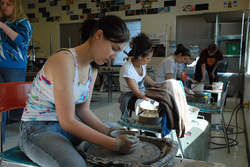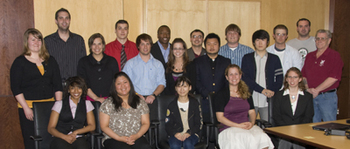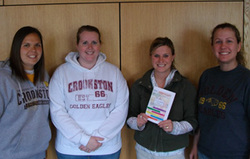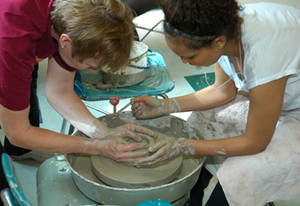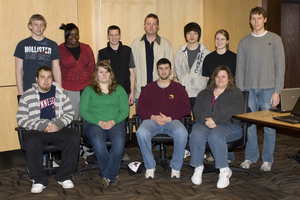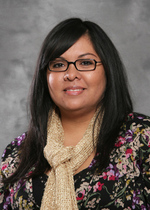Service learning has given students in the equine management class at the University of Minnesota, Crookston an opportunity to develop a business plan to help open a new Red River Valley Equestrian Center in Crookston. In 2009, a group of stakeholders investigated the potential for revitalizing the former Red River Valley Winter Shows building as an equestrian and agricultural educational and community center. An advisory committee was formed and recently engaged the help of the equine management class to help develop a business plan that includes updating the facility and the sustained use of it for both entertainment and education in the years to come.
While the U of M, Crookston is in no way affiliated with the Red River Valley Equestrian Center, the faculty, staff, and students have been volunteering time to help in its establishment. The equine management class, taught by ADawn Melbye, an instructor in the Agriculture and Natural Resources Department on the Crookston Campus, is working closely with Lisa Loegering, assistant director of service learning, on the aspects of the project. There are currently five phases to the students' business plan that will eventually encompass the entire building. Committees formed by students in the class work on the areas of boarding, finance, and marketing.
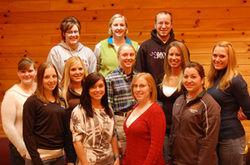
Members of the class include: Leah Stroot, a sophomore from Crookston, Minn.; Loraleigh Freer, a senior from Red Lake Falls, Minn.; Casey Wollangk, a senior from Reynolds, N.D.; Elsa Lunden, a junior from Annandale, Minn.; Steph Roland, a senior from East Grand Forks, Minn.; Mindy Nieuwboer, a senior from Kenneth, Minn.; Ashley Allen, a senior from Buffalo, Minn.; Jess Biddle, a senior from Elburn, Ill.; Nicole Veres, a senior from Random Lake, Wis.; Megan Hannon, a senior from Green Bay, Wis.; Brittney Skoien, a senior from Wannaska, Minn.; Tandra Klein, a junior from Hazen, N.D.; Melinda Baszczynski, a senior from Earlham, Iowa; and Joy Hilliard, a senior from Andover, Minn.
The class is also putting in some hands-on time working to restore parts of the facility including the middle barn and the north arena. The middle barn is being set up with stalls for boarding horses and on April 24, 2010, as part of National Youth Service Day, an effort will be undertaken by students to paint the building.
"We are excited to assist in this revitalization of the Red River Valley Winter Shows building as the Red River Valley Equestrian Center," Melbye says. "The facility will be a great place for equine activities as well as cattle shows, rodeo events, car shows, or for use by community clubs and other activities. This opportunity gives our students an opportunity to develop a real-world business plan that has the potential to impact not only the community but the region as well."
During the 84-year history of Red River Valley Winter Shows, Inc., the building has been dedicated to use for the advancement of agriculture. Over the years, numerous events and educational experiences have been made available to residents of Polk County and the 14 surrounding counties of the Red River Valley. In 1997, the building was closed due to financial concerns and a declining economy. To learn more about the revitalization project, visit http://valleyequestriancenter.yolasite.com.
Today the University of Minnesota, Crookston delivers more than 25 bachelor's degree programs and 50 concentrations, including several online degrees, in agriculture and natural resources; arts, humanities and social sciences; business; and math, science and technology. With an enrollment of about 1,300 undergraduates, the Crookston campus offers a supportive, close-knit atmosphere that leads to a prestigious University of Minnesota degree. "Small Campus. Big Degree." To learn more, visit www.umcrookston.edu.
In the photo: Equine Management Class Back row, (l to r): Leah Stroot, Loraleigh Freer, and Casey Wollangk. Middle Row: Elsa Lunden, Steph Roland, Mindy Nieuwboer, Ashley Allen, and Jess Biddle. Front Row: Nicole Veres, Megan Hannon, Brittney Skoien, and Tandra Klein. (Not pictured: Melinda Baszczynski, Joy Hilliard)
Contact: ADawn Melbye, instructor, Agriculture and Natural Resources Department, 218-281-8125 (amelbye@umn.edu); Elizabeth Tollefson, assistant director, communications, 218-281-8432 (ltollefs@umn.edu)


